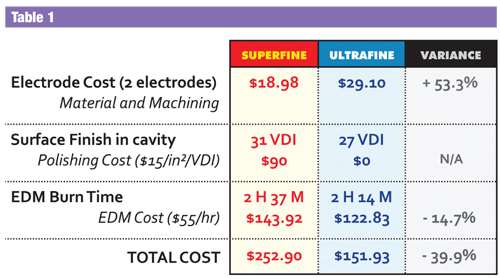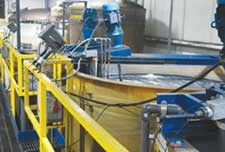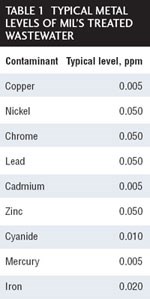Waste Treatment Without Wasted Space
System handles multiple process streams, fits tight footprint
Magnetic Inspection Laboratories Inc. (MIL; Elk Grove Village, IL) has been around for quite a while—since 1942, to be precise.
Magnetic Inspection Laboratories Inc. (MIL; Elk Grove Village, IL) has been around for quite a while—since 1942, to be precise. As the name suggests, the company began life as a non-destructive testing (NDT) house, providing magnetic particle, liquid penetrant, X-ray and other inspection services to customers in the aerospace and defense industries.
Since then both the company and its range of services have expanded considerably. MIL still offers NDT capabilities, and its customer list still reads like a Who's Who of aerospace and military primes including The Boeing Co., Lockheed Martin Corp., Bell Helicopter, Sikorsky Aircraft Corp. and Bombardier Inc. But over the years the company has gotten into the metal finishing business in a big way. MIL now operates multiple anodizing lines in addition to providing black oxide, chemical conversion coating for aluminum, chemical milling, electropolishing, pickling, etching, glass bead and abrasive blasting, passivation, Teflon impregnation, and zinc and manganese phosphating services in addition to liquid paint, Teflon coatings and dry film lubricants.
Featured Content
MIL's most recent push has been into electroplating. According to laboratory manager Corey Richardson, the company recently completed an expansion program that allowed it to add Type IC anodizing and cadmium cyanide electroplating processes to its capabilities list.
"Metal finishing accounts for more than half the business now," Richardson says, "We just started plating this year. We provide type I, II and III anodizing in addition to Type IC anodizing. Type IC anodizing is a more environmentally friendly substitute for chromic acid anodizing."
Coming online now is cadmium cyanide plating, a reflection of MIL's continued focus on military and aerospace applications. "Some of our managers had experience with cadmium plating, and with other platers getting out of the business and the military not having an alternative to cadmium in place, we thought we could pick up some of the slack," Richardson explains. "We've completed our testing on the cad plating line and are just starting to get orders."
Handling Wastewater
When it came time to plan a wastewater treatment system for MIL's new plating capabilities, managers had two priorities. Obviously, the system had to efficiently handle waste streams from a wide variety of processes. The second criterion involved the floor space available for the system.
"The space allotted for wastewater treatment was 25 x 80 ft," Richardson recalls. "To say the system was shoehorned in there doesn't quite do it justice."
MIL checked out several potential wastewater treatment vendors before selecting a design developed by J & T Technologies (Pottstown, PA). "We felt the J & T system handled high solids loadings better than other systems that were proposed, and they worked with us to fit everything into that tight space," Richardson explains.
Nominally sized to treat 120 gpm of mixed waste, the system features a duplex microfiltration system consisting of two independent subsystems, each capable of producing 120 gpm of filtrate. Each filter subsystem contains 24, 6-inch diameter x 6 ft long membrane modules, and each module has 10, 1-inch ID PVDF tubes with 15 ft2 of membrane surface.
The duplex setup enables one side of the microfilter system to be cleaned or undergo other maintenance while the other side handles all of MIL's filtration requirements. It uses membranes from Duraflow LLC (Tewksbury, MA) that are said to produce 40% more filtrate per square foot than competitive membranes, and MIL has discovered that the waster treatment system is capable of outperforming its rated capacity by a significant margin. "When the system is at its cleanest, we have hit as high as 215 gpm operating just one side," Richardson says. The system consistently handles 160–180 gpm of wastewater, he adds.
According to J & T, the microfiltration system removes precipitated metals better than, for example, a clarifier system. As with any pretreatment system prior to solids removal, chrome is reduced, cyanide is oxidized, and the pH is adjusted to the point of minimum solubility for the metal mix. Insoluble metals are then removed by the filters' 0.1-µm physical barrier without long chain polymers, eliminating concerns about particle size, density, electrostatic charge or the chance of overflowing to drain. Sludge volume is also greatly reduced, and the filtrate can in many cases be used for non-critical rinsing.
Richardson says MIL maintains the microfiltration system by cleaning the system every one to two weeks and using activated carbon to minimize fouling of filter membranes by organics, surfactants and silicates. "Surfactants and silicates are probably our biggest problems in terms of contaminants," he explains. "We tried calcium chloride first as a less expensive alternative, but it just didn't work as well—after a while we just had too many surfactants in the stream. Now we add about a bag of carbon a day, and it binds up the surfactants and effectively eliminates the problem."
Combined with the rest of the wastewater treatment system, microfiltration provides levels of metal contaminants that are consistently well below requirements. MIL monitors metals levels in the waste stream daily using atomic absorption spectrometry. Typical results are listed in the table.
Waste Treatment Process
Up to microfiltration, MIL's waste treatment process is fairly conventional. Incoming flows are segregated into separate tanks that hold concentrates, rinse waters, cadmium cyanide and chrome-bearing wastewaters.
"We knew we were adding cadmium plating, so that was definitely part of the planning for the waste treatment system," Richardson says. "It was designed for batch treatment, handling chrome and cadmium cyanide separately and then enabling us to commingle the flows after treatment. The system was installed in November 2008."
All acid and alkaline waste streams that don't contain cyanide or chrome enter a 6,500-gal equalization tank. Cyanide-bearing wastes flow into a 1,600-gal tank, and chromium-containing wastes are pumped to a 2,000-gal tank.
Concentrates are handled by batch treatment and cyanides are destroyed in a typical three-stage oxidation method. After primary precipitation, chrome-bearing waste gets pumped into a reduction tank where pH is dropped and Oxidation-Reduction Potential (ORP) adjusted.
MIL recycles some of the alkaline waste from its chemical milling operations by using it in place of a proprietary precipitant for metals. "It's highly alkaline with a high sulfide content, and we add it to the system upstream of the microfilters to aid in precipitating metals prior to filtration," Richardson explains.
Flows from the chrome and cyanide treatment systems commingle with the rest of the waste stream, which is subjected to pH neutralization, coagulation, and precipitation. The commingled flow is then pumped through the microfiltration system. From the microfilter, clear effluent is pumped to drain. Solids generated by microfiltration are allowed to settle in a thickening tank before being pumped to a filter press. Filter cake is sent to landfill as hazardous waste.
According to Richardson, the system has handled all the waste streams generated by MIL's array of processes and significantly reduced the company's output of hazardous wastes. "Previously, we operated a separate chromium treatment system, and we sent out most of our concentrated waste as hazardous," he explains.






















